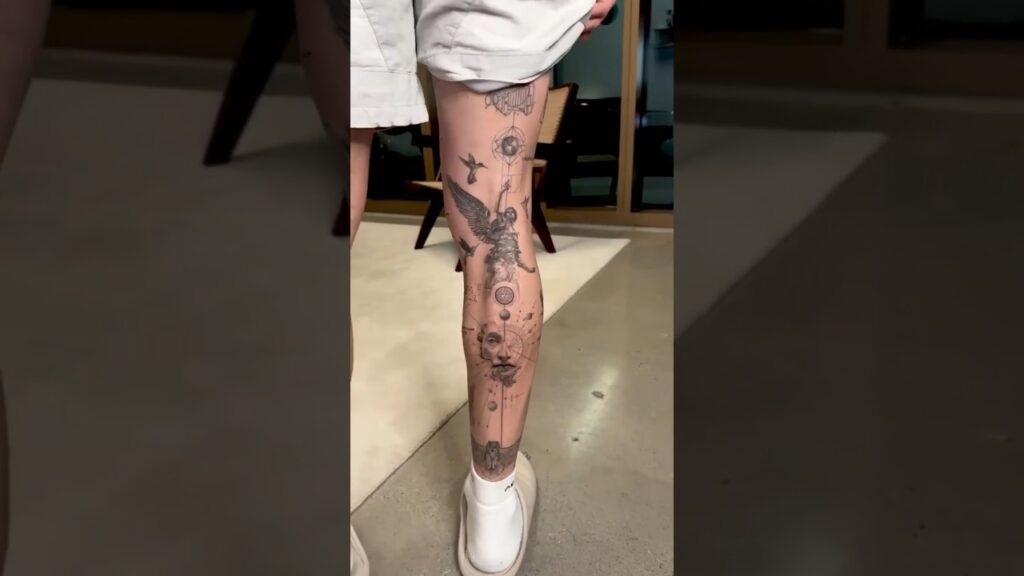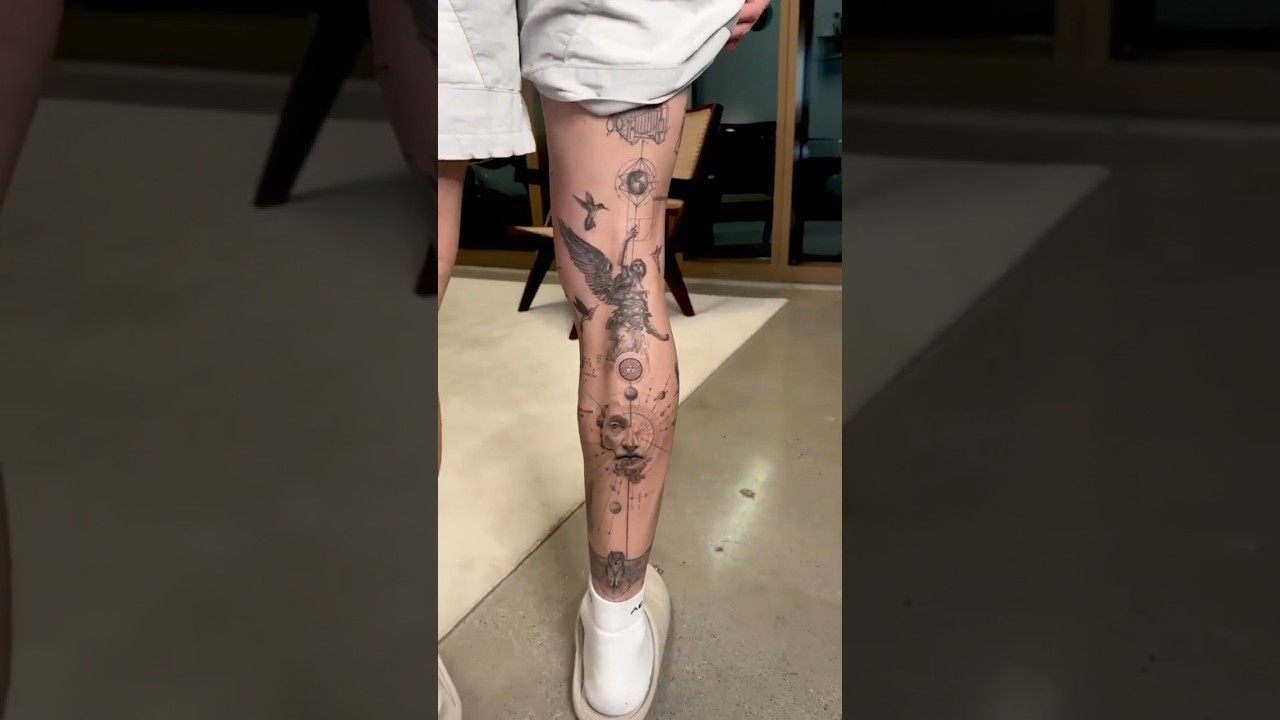
Introduction to Male Leg Sleeve Tattoos
Leg sleeve tattoos for men have become increasingly popular, offering a canvas for intricate designs and personal expression. Unlike smaller tattoos, a leg sleeve provides ample space for telling a story, showcasing artistic skill, and making a bold statement. This comprehensive guide delves into everything you need to know about male leg sleeve tattoos, from design ideas and placement considerations to pain levels and aftercare tips.
Why Choose a Leg Sleeve Tattoo?
Choosing a leg sleeve tattoo is a significant decision. Here are several reasons why men opt for this extensive form of body art:
- Ample Space: The leg provides a large canvas, allowing for detailed and complex designs that wouldn’t be possible on smaller body parts.
- Storytelling: A leg sleeve can be used to tell a story through interconnected images and symbols. This could be a personal narrative, a tribute to heritage, or a representation of core beliefs.
- Visual Impact: Leg sleeves are visually striking and can be a significant part of a man’s personal style.
- Versatility: While easily visible in shorts or swimwear, a leg sleeve can be concealed under long pants for professional or formal settings.
Popular Leg Sleeve Tattoo Designs for Men
The possibilities for leg sleeve tattoo designs are virtually endless. Here are some of the most popular and inspiring ideas:
1. Biomechanical Leg Sleeve Tattoos
Biomechanical tattoos blend organic and mechanical elements, creating a futuristic and often surreal effect. These designs often feature gears, wires, and robotic components integrated with muscle and bone structures.
Key Elements: Gears, pistons, wires, robotic parts, organic tissue, shading for depth.
Suitable For: Men interested in technology, science fiction, and a visually complex aesthetic.
2. Japanese Leg Sleeve Tattoos
Japanese tattoos, also known as Irezumi, are rich in symbolism and tradition. Common motifs include dragons, koi fish, tigers, and mythical creatures, often accompanied by waves, clouds, and flowers.
Key Elements: Dragons (symbolizing wisdom and strength), koi fish (representing perseverance and transformation), tigers (denoting courage), cherry blossoms (signifying the fleeting nature of life), waves and clouds (adding dynamic background elements).
Suitable For: Men who appreciate Japanese culture, history, and art, and who seek powerful and meaningful symbols.
3. Tribal Leg Sleeve Tattoos
Tribal tattoos are inspired by indigenous cultures around the world, including Polynesian, Maori, and Native American designs. These tattoos often feature bold lines, geometric patterns, and symbolic representations of nature and ancestry.
Key Elements: Bold black lines, geometric shapes, spirals, tribal masks, animal motifs, and cultural symbols.
Suitable For: Men who want to honor their heritage, connect with ancient traditions, or showcase a strong and masculine aesthetic.
4. Nature-Themed Leg Sleeve Tattoos
Nature-themed tattoos celebrate the beauty and power of the natural world. These designs can include forests, mountains, oceans, animals, and plants, often rendered in realistic or stylized forms.
Key Elements: Trees, mountains, rivers, oceans, animals (wolves, bears, eagles), plants (flowers, leaves), and natural landscapes.
Suitable For: Men who love the outdoors, appreciate nature’s beauty, and seek a connection with the environment.
5. Religious and Spiritual Leg Sleeve Tattoos
Religious and spiritual tattoos express faith, beliefs, and values. These designs can include religious figures, symbols, scriptures, and mandalas, often rendered with intricate detail and reverence.
Key Elements: Crosses, angels, Buddha, deities, religious texts, mandalas, spiritual symbols, and geometric patterns.
Suitable For: Men who want to express their faith, seek spiritual guidance, or honor their religious traditions.
6. Portrait Leg Sleeve Tattoos
Portrait tattoos capture the likeness of loved ones, heroes, or historical figures. These designs require a skilled artist to accurately render facial features, expressions, and details.
Key Elements: Realistic portraits, shading for depth, attention to detail in facial features, and background elements that add context.
Suitable For: Men who want to honor someone special, commemorate a significant person, or showcase their artistic appreciation.
7. Horror-Themed Leg Sleeve Tattoos
Horror-themed tattoos embrace the dark and macabre, featuring monsters, demons, skulls, and other chilling imagery. These designs are often bold, graphic, and visually striking.
Key Elements: Skulls, demons, monsters, zombies, ghosts, blood, and dark shading.
Suitable For: Men who enjoy horror films, literature, and art, and who seek a bold and edgy aesthetic.
Placement Considerations for Leg Sleeve Tattoos
The placement of your leg sleeve tattoo is crucial for its overall impact and aesthetic appeal. Here are some factors to consider:
1. Full Leg Sleeve vs. Half Leg Sleeve
A full leg sleeve covers the entire leg, from the upper thigh to the ankle, while a half leg sleeve typically extends from the knee to the ankle or from the upper thigh to the knee. Consider the amount of coverage you desire and how it will fit with your lifestyle and wardrobe.
2. Front, Back, or Side Placement
The front of the leg offers a prominent display area, while the back of the leg provides a more concealed option. Side placement can offer a unique perspective and allow for a more flowing design.
3. Contour and Movement
Work with your artist to design a tattoo that complements the natural contours and movement of your leg. This will ensure that the tattoo looks dynamic and visually appealing from all angles.
4. Existing Tattoos
If you already have tattoos on your leg, consider how the new sleeve will integrate with them. You may need to incorporate existing tattoos into the design or choose a placement that allows for a cohesive and balanced look.
The Tattoo Process: What to Expect
Getting a leg sleeve tattoo is a significant commitment that requires multiple sessions. Here’s what you can expect during the process:
1. Consultation
The first step is to consult with a skilled tattoo artist. Discuss your design ideas, placement preferences, and any concerns you may have. The artist will provide feedback, offer suggestions, and create a custom design that suits your vision.
2. Stencil Application
Once the design is finalized, the artist will create a stencil and apply it to your leg. This allows you to see how the tattoo will look on your body and make any necessary adjustments before the tattooing begins.
3. Tattooing Sessions
Leg sleeve tattoos typically require multiple sessions, each lasting several hours. The artist will use a tattoo machine to inject ink into the skin, following the lines of the stencil. Be prepared for some discomfort and potential pain, especially in sensitive areas like the shin and ankle.
4. Healing Process
After each session, your tattoo will need time to heal. Follow your artist’s aftercare instructions carefully to prevent infection and ensure proper healing. This typically involves cleaning the tattoo regularly, applying a healing ointment, and avoiding sun exposure and excessive moisture.
Pain Level and Management
The pain level of a leg sleeve tattoo can vary depending on the individual’s pain tolerance, the placement of the tattoo, and the complexity of the design. Generally, areas with less fat and more nerve endings, such as the shin, ankle, and knee, tend to be more painful. Here are some tips for managing pain during the tattoo process:
- Stay Hydrated: Drink plenty of water before, during, and after your tattoo sessions.
- Get Enough Sleep: Being well-rested can help you better tolerate pain.
- Eat a Good Meal: Have a substantial meal before your session to keep your energy levels up.
- Take Breaks: Don’t hesitate to ask for breaks during the tattooing process.
- Use Numbing Creams: Topical numbing creams can help reduce pain, but consult with your artist before using them.
- Distract Yourself: Listen to music, watch a movie, or talk to your artist to take your mind off the pain.
Aftercare Tips for Leg Sleeve Tattoos
Proper aftercare is essential for ensuring that your leg sleeve tattoo heals properly and looks its best. Here are some essential aftercare tips:
- Keep the Tattoo Clean: Gently wash the tattoo with mild soap and warm water 2-3 times a day.
- Apply Healing Ointment: After washing, apply a thin layer of healing ointment, such as Aquaphor or Tattoo Goo.
- Avoid Sun Exposure: Protect your tattoo from direct sunlight by wearing loose-fitting clothing or using sunscreen.
- Avoid Soaking: Avoid swimming, baths, and hot tubs until the tattoo is fully healed.
- Don’t Pick or Scratch: Resist the urge to pick or scratch the tattoo, as this can cause infection and damage the design.
- Stay Hydrated: Continue to drink plenty of water to keep your skin hydrated and promote healing.
- Wear Loose Clothing: Wear loose-fitting clothing to avoid friction and irritation.
Choosing the Right Tattoo Artist
Selecting the right tattoo artist is crucial for achieving a leg sleeve tattoo that you’ll love for years to come. Here are some factors to consider:
- Portfolio: Review the artist’s portfolio to assess their skill, style, and experience. Look for examples of leg sleeve tattoos that align with your design preferences.
- Reputation: Read reviews and testimonials from previous clients to gauge the artist’s reputation and customer service.
- Consultation: Schedule a consultation to discuss your design ideas and assess the artist’s communication skills and professionalism.
- Hygiene: Ensure that the tattoo studio is clean, sterile, and adheres to strict hygiene standards.
- Licensing: Verify that the artist is licensed and certified to practice tattooing in your area.
Cost of a Leg Sleeve Tattoo
The cost of a leg sleeve tattoo can vary depending on several factors, including the artist’s hourly rate, the complexity of the design, the size of the tattoo, and the number of sessions required. On average, a full leg sleeve tattoo can cost anywhere from $2,000 to $10,000 or more. Be sure to get a detailed estimate from your artist before committing to the project.
Maintaining Your Leg Sleeve Tattoo
Once your leg sleeve tattoo is fully healed, it’s important to maintain it properly to keep it looking vibrant and fresh. Here are some tips for maintaining your tattoo:
- Moisturize Regularly: Apply a quality moisturizer to your tattoo daily to keep the skin hydrated and prevent fading.
- Protect from Sun Exposure: Always wear sunscreen when exposed to the sun to prevent fading and damage.
- Avoid Harsh Chemicals: Avoid using harsh soaps, detergents, and chemicals on your tattoo.
- Stay Healthy: A healthy lifestyle, including a balanced diet, regular exercise, and adequate sleep, can help keep your skin healthy and your tattoo looking its best.
Conclusion
A male leg sleeve tattoo is a significant investment in self-expression and body art. By carefully considering your design options, placement preferences, and aftercare practices, you can create a stunning and meaningful tattoo that you’ll be proud to show off for years to come. Remember to choose a skilled and reputable artist who can bring your vision to life and provide expert guidance throughout the process.

